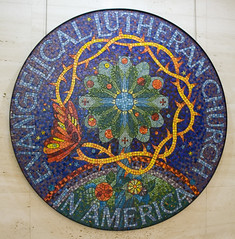
Chelsea, New York City. February 14, 2012
365 Part Deux


A couple of weeks ago, Father Anonymous over at Magdalene’s Egg, asked for a scan of a pamphlet from 1903 regarding individual communion cups. It peaked my interest (to the point where one of my seminary papers will be about the development and rise of the little shot glasses). I wasn’t able to find that pamphlet (since I’m in NYC) but, lo and behold, a similar document was posted in the minutes of the ministerium of Pennsylvania from 1903 and google books has a copy of it. Sadly, the pdf you can download is all images so I’ve reproduced some of what I found here.
156th Annual Convention of the Evangelical Lutheran Ministerium of Pennsylvania and Adjacent States
Philadelphia PA
June 4th to 10th, 1903
It seems that, during the Seventh Session (Tuesday June 9th at 9 am), during a resumption of the Report on Unfinished Business, the opinion of the faculty in regards to communion cups was received and “adopted as the expression of the sense of the Synod upon this point” (see page 71). This response was written at the request of the Ministerium in 1902 on why individual communion cups shouldn’t be used (see Eng. Min., 1902 page 30; Germ. Minutes, 1902 p 32). In the 1902 minutes, on page 30, it’s reported that the Ministerium reaffirmed its actions of 1895 (Eng min p 25:10): “That we unqualifiedly condemn the introduction of the individual communion cup.” This number on the agenda was item 13 which was a request from the congregation at Nazareth, PA, that the ministerium reaffirm its action from 1895. Note: If someone could score a copy of what happened in 1895, I would appreciate it.
June, A.D. 1903 page 161
Appendix I. “The Individual Communion Cup”
Opinion of the Philadelphia FacultyWithin the last few years, an innovation in the mode of administering the Lord’s Supper has been introduced into many congregations of other denominations, and into a few of our own name in this country. As long as there was no danger of interference with the uniformity that has prevailed in our churches this innovation could very properly be left unnoticed. But since a few of our congregations have been agitated by the example and the discussion in other denominations, the time has come, in the judgement of the Evangelical Lutheran Ministerium of Pennsylvania, for an opinion on the subject.
The practice referred to is that of the so-called “individual communion cup.” According to it, in the administration of the Holy Supper, each communicant takes from a try, offered by the officiating pastor, a minute cup containing a small amount of wine, and, after having drunk, replaces the cup in the tray. The plan provides also in large congregations for the washing of the emptied vessels while the communion proceeds, in order that they may be refilled for subsequent communicants.
In regard to this practice, we must concede that it belongs to the non-essentials of the sacrament. The sacrament is not destroyed by the variation in the mode of its administration. If the practice, abolished by the protests of Ph. J. Spener, of Administering the wine through reeds or tubes, were to be re-introduced, the sacrament itself would be unaffected. Nor would it be any the less the Lord’s Supper if, according to ancient practice, the wine were largely diluted with water. These are non-essentials; but, nevertheless, they are matters of no light moment. The essentials of a sacrament may be unaffected, while, with it, there may be practices interfering with its impressiveness, destroying reverence for a holy ordinance of God, disturbing the minds of devout communicants, and confusing the order of the Church.
Our Fathers, in the Formula of Concord (Solida Declariation, x:9) have declared:
“We believe, teach and confess that, in regard to adiaphora, the Church of God, of every time and place, has the fullest power, according to circumstances, to change, abrogate and appoint anything, provided it be done without levity and offense, becomingly, and in good order, and that, at each particular time, regard be had to that which, to the greatest extent, promotes good order, godly discipline, and the edification of the Church.”A change, even though it be in regard to matters that are of themselves adiaphora, which completely antagonizes and revolutionizes a practice sanctions not only by the usage of the Church in all ages, in all lands and under all Confessions, where the cup has not been denied the laity, but also by the example of the Apostles and the institution of our Lord Jesus Christ Himself, should not be contemplated by individual pastors and congregations, except in consultation and agreement with the churches with which they are synodically united. The good order of the Church and the edification of believers are not promoted by radical changes in the administration of the Holy Supper, that occasion great diversities and contrasts among congregations that profess to stand in closet fellowship with one another. Wherever the practice is unusual, the mind of the communicate is withdrawn from “the chief thing” in the sacrament, the words, “for you,” to the innovation, and to all the associations that have suggested and the arguments urged for its introduction.
The historical practice, observed by our churches, teaches, with great force and clearness, the fact that, while our Lord, by the gift of His Body and Blood to the individual communicant, assures him individually of the forgiveness of sins, the communion is not to separate, but to unite, believing children of God with one another. As a pledge of such union, the Lutheran Order of Service lays particular emphasis on the common cup. The exhortation in the Church Book and Common Service eliminates in the words: “For we are all one bread and one body, even as we are all partakers of this one bread, and drink of this one cup. ” The principle is not necessarily that of an entire congregation being restricted to but one cup at an administration, but that of a number of communicants drinking from the same vessel, as a testimony to the common bond that unites them in soul and body by partaking of the same Lord. What they elsewhere shrink from doing, they cheerfully do here, in recognition of their Lord’s unspeakable love to them and to each, even the least and the vilest, of their brethren.
As to the one argument upon which the innovation rests, that of the danger of incurring disease, the lists of the hundreds of thousands communing yearly in our churches, and of the repetition of similar communions in all Protestant churches, for nearly four hundred years now, since the Reformation, is a stronger argument than that urged by the professed scientific spirit of any particular age. If there be remote danger, this is found not only in the use of a common cup, but also in inhaling the same air, a peril which can be avoid only by completely isolating ourselves from our fellow-men.
The refinements of modern life have, after all is said, probably more to do with the proposed change than even sanitary reasons. It must be acknowledged that, where proper precautions are not employed by pastors, there are abused which give much ground for offense. Every possible care should be taken to cleanse the cup continually during the administration and fulfill every requirement suggested by regard for cleanliness and decency. Ordinary prudence will indicate that special attention should be given to communicants whose participation in a general communion might, because of disease or other serious physical cause, render others reluctant to commune after them.
With these precautions, there is no reason among us for deviating from the historical practice.
Where variation from it occurs, a revision of the entire Communion service should be necessitated. The innovation is foreign and antagonistic throughout the spirit of the Lutheran Church. Denominations in which the Lord’s Supper is distributed not by the pastor but by church officers, through the pews or otherwise, for their own self-administration, can adopt the change far more readily than a Church which seeks most directly and immediately to reach the individual communicant with word and element applied through the pastor. The innovation sacrifices the individualization of the word to the individualization of the cup. Neither “good order,” nor “good discipline,” nor “the edification of the Church” either requires or even advises it. Until a demand, based on such reasons, be recognized by the general agreement and official action of the Church, no individual pastor or congregation should yield to any sudden clamor for it, and thus arbitrarily separate from the common and approved practice of the Church.
The Faculty
Mount Airy, Philadelphia, March 18th, 1903.
Minutes of the Proceedings of the annual convention of the Evangelical Lutheran Ministerium of Pennsylvania and the Adjacent States, Issues 153-158
Google eBook
Page 626-627 in 1051 page PDF
I’m just going to come out on the record that the ELCA needs to spend more resources on parodying pop standards. And, yes, I do consider Miley Cyrus part of the pop-standard iconography.
This was filmed, and possibly written, last week during the big ELCA Youth worker event down in New Orleans. It’s not half bad.

 For about a month now, there has been a blog post brewing in my brain. Every time I set down to write it, nothing really comes out. But the post is there, lurking. I find myself walking my dog and thinking about it. Every once in awhile, my thoughts return to it. And when I’m standing in worship at my field site, my home church, or my seminary, the post comes back to life.
For about a month now, there has been a blog post brewing in my brain. Every time I set down to write it, nothing really comes out. But the post is there, lurking. I find myself walking my dog and thinking about it. Every once in awhile, my thoughts return to it. And when I’m standing in worship at my field site, my home church, or my seminary, the post comes back to life.
But I still haven’t figured out what to say about it.
The thoughts started bubbling after reading about the white middle class captivity of the ELCA. I buy a lot of what Rev. Clint said – whenever I leave New York City and enter an ELCA church, I’m always aware of how brown I am. That doesn’t surprise me nor shock me. I honestly think that you could probably argue that the ELCA is still heavily tied to its immigrant roots, still heavily American but not entirely (or what not). My not being a cradle Lutheran and spending most of my time experiencing the urban version of Lutheranism probably taints my view quite a bit. And it probably doesn’t help that I’m Hispanic.
My issue with this kind of thinking isn’t that it’s false. I think its very valid. Asking the question why the ELCA is middle class & white and asking the question how to get that to change – those are good questions. And being honest with our own personal stake in the ELCA being the way it is, that’s great too. In fact, wherever I end up is probably not going to look a lot like me. And I’m use to that. But I’ve been wondering – if we keep saying that the church is too white, too middle class, too this or too that – what does that say about the members of our church who aren’t white and who are poor? And what do we do about the members of our denomination who claim that identity and say “hey, I don’t buy into that?”
I don’t know – maybe no one will say that. But I’ve been thinking about it. There’s something very good about the corporate body saying “oh hey, we’re too much like this. We need to change.” I’m down with that. But there is a part of me that doesn’t mind thinking “well, that’s not me.” So what’s the trick then? To be honest about who we are as an organization but also be open enough so that all minority groups can lay a claim to it, own it, and say that the ELCA is me and then some? Or is this a tad too personal and I’m trying too hard to stick out? I don’t know.
But if we’re really trying to get all sorts of groups to buy into what it means to be in the ELCA (or the Church, church, Christianity, etc) – how do we mean it? That I haven’t figured out.
I know what the Metro-New York Synod has been doing to try and change that feeling. I know we have lots of assistants to the bishops that are minorities. That’s good, to a degree. And I think there’s something valuable of having someone that “looks like me” in a position of hierarchical power. But if you’re part of a synod that also says its going to close 50 churches..well….
I’m not sure where I’m going with this. But I’m slowly drawing into it the question I’ve had about what it means to buy into the ELCA. In fact, that term, “buy in,” is probably becoming some sort of rallying point for my thoughts and there’s probably some dangerous theological problems with just using the term “buy in.” But well, hey, I’ve never been a fan of using the term “loyalty” (as in, there is no denominational loyalty anymore) that I keep hearing too.
I wonder if any of this kind of thinking will lead anywhere.

Today after church, K and I took a trip to the Lower East Side. We visited our favorite dumplings place (Vanessa’s), ran a few errands, and then popped into a new store: Jane’s Exchange: Children & Maternity Consignment.
With K being 19 weeks along, the need for new clothes is rather high. Luckily K was raised by a mother who loved thrift stores and passed those genes on down. While she rummaged through the wide selection of maternity clothes, babby clothes, toys, and games, I sat and read for Seminary (a feminist perspective on Matthew and Luke-Acts anyone?). The longer I sat, the more clothes, books, and other items were piled on top of me to “hold”. Before you knew it, I was buried in babby goodness. A book about pregnancy, a couple of Richard Scary board books, two really tiny books about Noah and King David (sadly missing the Goliath and the Bathsheba incident), and a ton of onesies covered me. With my reading done, I called K to dig me out.
As we headed to the check out, we noticed behind the counter a used Sophie Giraffe. As its maker claims, it is the most famous baby toy IN ALL THE WORLD. This Giraffe that squeaks (Twinkie is under the mistaken opinion that it is for her) will run you around $25 retail (a little cheaper on Amazon). It is the toy that when I run into expectant mothers at seminary, I ask whether they received one at their baby shower. Most think the toy is silly but we all agree that we must have one and Lord have mercy on the woman who does not get one. So there it was, behind the counter, staring at us, for only five bones. We snapped it up, no questions asked. A used teething toy that’s in great shape and looks like it never was used? Heck yes.
While walking towards our next appointment, we got to joking with each other. K said, adamantly and loudly on Avenue B that our kidling “deserves all the best things! … Well, used best things.” And it’s true. He does. And based on the pictures I took of K while waiting for the L train, he’ll get them.



